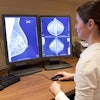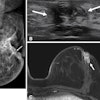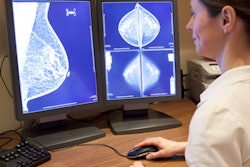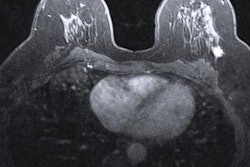
What's the most effective breast cancer screening strategy for women ages 40 to 49? Perhaps no screening at all for those deemed to be low risk by an artificial intelligence (AI) algorithm, according to research based on a simulation model published online May 6 in BMC Cancer.
Researchers from Memorial University of Newfoundland in St. John's, Canada, used a decision tree and simulation model to assess the cost-effectiveness of eight different breast cancer screening strategies. They found that the most cost-effective approach relied on AI analysis of an index screening mammogram for risk stratification; women identified as low risk would not receive any additional screening in their 40s, while high-risk women would have annual screening mammograms.
"By accurately identifying and screening more high-risk women and avoiding screening for low-risk women, this cost-effective AI-based screening strategy can help address existing concerns about delayed diagnoses as well as false-positive diagnoses that could arise with conventional screening strategies," wrote Shweta Mital and Dr. Hai Nguyen.
The researchers analyzed cost-effectiveness of the following eight different mammography screening strategies for women ages 40 to 49:
- No screening
- Annual screening for all women beginning at age 40
- Screening based on AI analysis of index screening mammogram at age 40: Women predicted to be high risk would receive annual screening mammography, while those predicted to be low risk wouldn't receive screening
- Screening based on AI analysis of index screening mammogram at age 40: Women predicted to be high risk would receive annual screening mammography, while those predicted to be low risk would receive biennial screening mammography
- Screening based on polygenic risk scores from genetic testing: Women predicted to have high risk from the polygenic risk score would receive annual screening, while women deemed to be low risk wouldn't receive screening
- Screening based on polygenic risk scores from genetic testing: Women predicted to have high risk from the polygenic risk score would receive annual screening, while women deemed to be low risk would receive biennial screening
- No screening in women with no family history of breast cancer
- Biennial screening in women with no family history of breast cancer
Once women reached 50 years of age, screening strategies followed guidelines from the U.S. Preventive Services Task Force (USPSTF). The researchers developed a hybrid decision tree/microsimulation model to estimate the costs and effectiveness -- via quality-of-life years -- of all eight screening strategies on 100,000 white women with no previous history of breast cancer.
The use of AI and no screening for low-risk women dominated other screening strategies in terms of cost-effectiveness, according to the researchers. It was also cost-effective in comparison with no screening, yielding an incremental cost-effectiveness ratio of $23,755 per quality-adjusted life-year gained.
Using AI to risk-stratify women and targeting screening at only high-risk women can generate more economic value than existing screening guidelines, according to the researchers.
"Compared with family history-based screening (which reflects current USPSTF guidelines), this AI-based strategy can help alleviate existing concerns about delayed diagnoses as more high-risk women would be accurately identified and screened," the authors wrote. "At the same time, it can reduce false-positive diagnoses from screening all women over age 40 annually (as recommended by [American College of Obstetricians and Gynecologists]/[American College of Radiology] guidelines)."




















